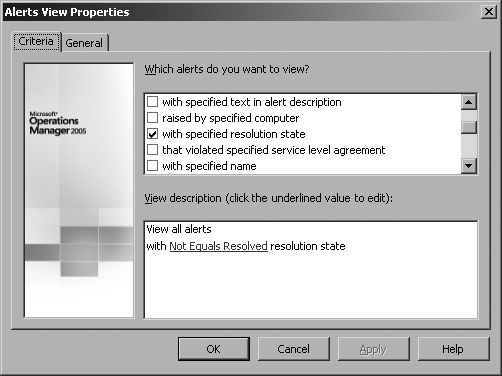Views
Views, as represented by the view buttons, are collections of database queries that share a common theme. Each individual query in a view group extracts the same type of information from the operations database, but all views are all a variation on that theme. For example, alert view queries (also called view objects) all return alert data, but while one does so for alerts related to Active Directory, another does so for Exchange- or MOM-related alerts, and so on. You see these variations in the upper portion of the navigation panel.
To understand how a view query works, open its properties field. An individual view query is made up of a name, optional description, the data type being queried, and the parameters the query is using to filter. A good example of a simple view query is the All Alerts Query. Figure 6-14 shows the properties of the All Alerts View - Alerts query.

Figure 6-14. The properties of the All Alerts View - Alerts
This alert query is looking for alerts with a specific value in the resolution state field. In this case, it is the Not Equals Resolved value. By clicking on the Not Equals Resolved text, you are taken to a dialog box where you specify the desired resolution state or states.
All view queries follow this same pattern and range from the very simple (see Figure 6-14) to the very complex, which include conditional statements and time ranges. Every view query ...
Get Essential Microsoft Operations Manager now with the O’Reilly learning platform.
O’Reilly members experience books, live events, courses curated by job role, and more from O’Reilly and nearly 200 top publishers.

